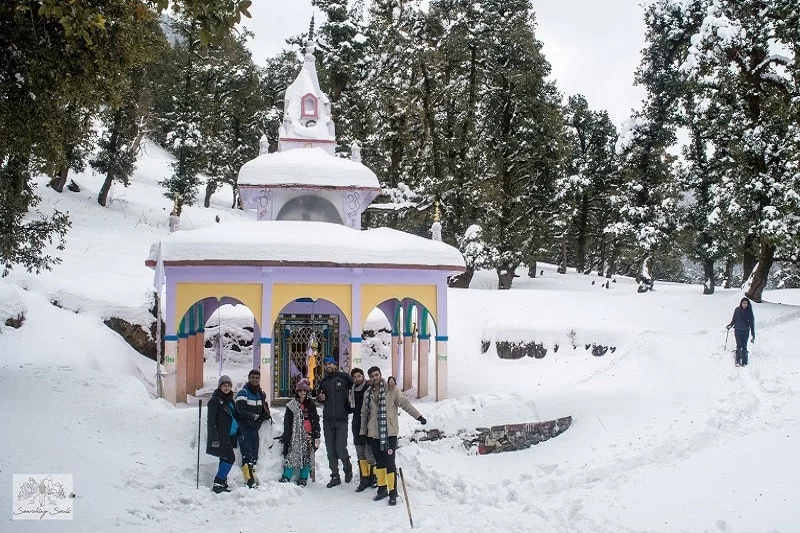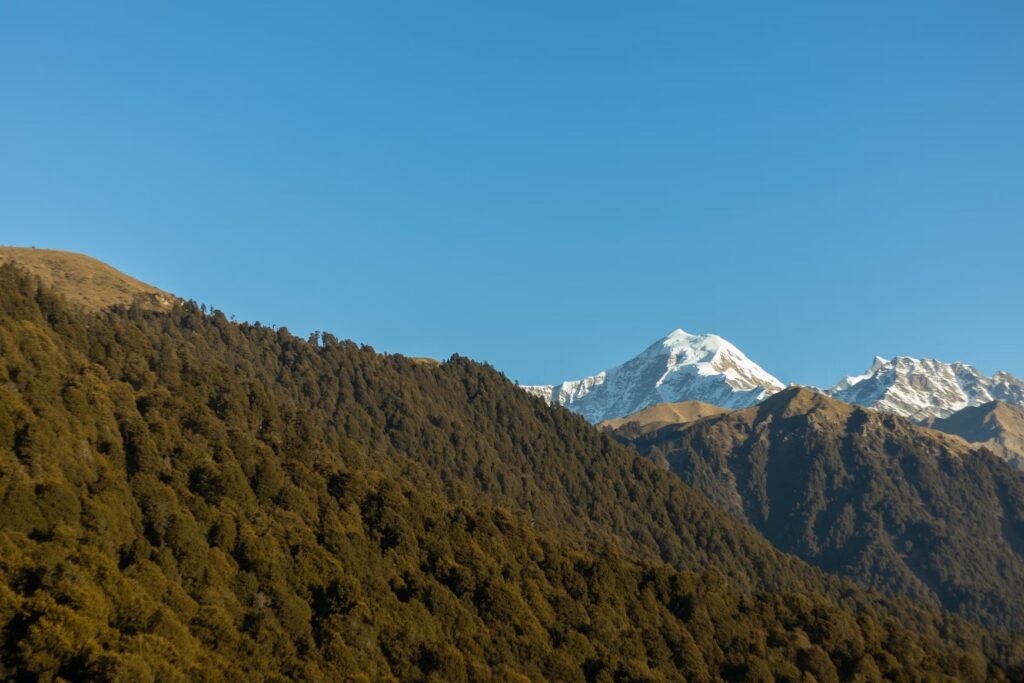Introduction to Nag Tibba trek
Nestled in the enchanting landscapes of the Himalayas, Nag Tibba trek stands as an unspoiled gem waiting to be explored. This article will take you on a journey through this Himalayan paradise, unveiling its natural beauty and the thrilling adventures it offers to travellers seeking a unique experience.
What is Nag Tibba trek?
Nag Tibba trek, often referred to as the ‘Serpent’s Peak,’ is the highest peak in the lesser Himalayan region of Uttarakhand, India. It is a trekker’s paradise, offering a breathtaking view of the snow-clad peaks, dense forests, and an opportunity to explore the rich biodiversity of the region.
The Journey Begins: Getting There

1. Dehradun – The Gateway
The adventure to Nag Tibba trek starts from Dehradun, the capital city of Uttarakhand. Dehradun is the best place to begin your journey because it is well-connected by road, rail, and air. Spend some time in Dehradun, exploring its colonial architecture and vibrant culture before embarking on your trek. If you are looking for a trek Nag Tibba Check out The Searching Souls.
2. The Drive to Pantwari
From Dehradun, a scenic drive of approximately 85 kilometers will take you to Pantwari village, the base camp for the Nag Tibba trek. The trip itself offers a chance to take in the area’s natural splendor. Along the way, you’ll pass through picturesque villages and terraced fields, giving you a glimpse of local life.
The Trek: Into the Wilderness
3. Nag Tibba Base Camp to Pantwari
The trek begins officially at Pantwari. It takes roughly four to five hours to hike to the base camp of Nag Tibba. The trail is adorned with oak and rhododendron forests, offering a glimpse of the region’s rich flora. As you hike, the chirping of birds and the rustling of leaves will be your companions.
4. The Beauty of the Oak and Rhododendron Forests
While trekking, you will be surrounded by the mesmerizing beauty of oak and rhododendron forests. These vibrant forests create a striking contrast with the white snow and are a visual treat for nature enthusiasts and photographers. Take your time to immerse yourself in this natural wonder, capturing the unique flora and fauna that thrive in this region.
5. Nag Tibba Base Camp
Upon reaching the base camp, you’ll be welcomed by the stunning views of the Garhwal Himalayas. Trekkers can find shelter at the base camp, which also acts as the beginning of the last ascent to Nag Tibba. It’s also a hub of camaraderie, where fellow trekkers share stories, food, and warmth. The sense of community is an essential part of the Nag Tibba experience.
6. Sunrise at Nag Tibba
Wake up early to witness the majestic sunrise over the Himalayan peaks. The golden hues of the rising sun reflecting on the snow-clad mountains create a surreal and unforgettable experience. This is the moment when you feel the magic of the mountains, a connection that transcends words.
7. The Ascent to Nag Tibba Summit
The last climb to the summit of Nag Tibba is a thrilling and steep adventure. The panoramic view from the summit is awe-inspiring, with peaks like Swargarohini, Bandarpoonch, and Kala Nag visible on a clear day. You’ll find yourself on top of the world, with the vast expanse of the Himalayas laid out before you. It’s a moment of triumph and humility, where you realize the grandeur of nature.
A Glimpse of the Adventure
8. Camping under the Stars
For those seeking adventure, camping at the Nag Tibba base camp or higher up in the mountains is a thrilling experience. The starry night sky and the distant howls of wolves create an atmosphere of pure wilderness. As you sit by the campfire, sharing stories and laughter with your fellow trekkers, you’ll appreciate the simplicity of life in the mountains.
9. Birdwatching and Wildlife
The Nag Tibba trek offers opportunities for birdwatching and glimpses of wildlife. Keep your eyes open for Himalayan Monals, mountain goats, and sometimes even leopards. This hike is more about the journey than the final destination—it’s about those unexpected moments when you get to see Himalayan wildlife in its native environment.
10. Nag Tibba in Winter
If you’re a fan of snow, visiting Nag Tibba in the winter months is a different kind of adventure. The landscape transforms into a winter wonderland, offering a unique and tranquil experience. The crisp mountain air, the pristine snow, and the peaceful solitude create a winter trekking experience like no other.
11. Customs of the Area
Engaging with the local communities and discovering their customs and culture is another opportunity offered by the Nag Tibba trek. You can experience the warm hospitality of the Garhwali people. They’ll welcome you into their homes, share traditional meals, and regale you with stories of life in the mountains. It’s a cultural exchange that enriches your journey.
12. The Sacred Nag Temple
Nag Tibba is named after the serpent deity, and the trek is associated with a small Nag Temple located on the summit. This temple holds religious significance for the locals, and it’s a serene place for trekkers to reflect and find peace.
13. Flora and Fauna Diversity
The Nag Tibba region boasts a rich diversity of flora and fauna. Explore the lush green forests to spot a variety of bird species, from Himalayan Monals to raptors. Keep an eye out for wildlife like mountain goats and leopards.
14. Nag Tibba as a Photography Paradise
Photographers will find Nag Tibba a paradise for capturing breathtaking landscapes. The changing hues of the sky at sunrise, the vivid rhododendron blooms, and the rugged terrain offer endless opportunities for stunning shots.
15. Other Nearby Treks
Nag Tibba is not the only trek in the area. There are other treks like Har Ki Dun, Ruinsara Tal, and Kedarkantha that offer equally mesmerizing experiences for trekkers, making Uttarakhand a haven for trekking enthusiasts. And don’t forget the challenging and awe-inspiring Pangarchulla Peak trek, which beckons seasoned trekkers with its thrilling ascent and panoramic views of the Garhwal Himalayas.
Conclusion
Nag Tibba is more than just a trek; it’s a journey into the heart of the Himalayas. This hidden gem showcases nature’s beauty and provides adventure seekers with a thrilling experience. The trek offers a sense of accomplishment and a deep connection with the mountains. So, when you’re looking for an offbeat adventure in the Himalayas, remember Nag Tibba. “Join The Searching Souls on Nag Tibba Trek, and let the Himalayas enchant you with its beauty and mystique.”
FAQs
1. Is Nag Tibba appropriate for novices?
Nag Tibba is an ideal choice for beginners due to its moderate difficulty level. It’s a great way to start your trekking journey in the Himalayas.
2. What time of year is ideal for visiting Nag Tibba?
When the weather is nice, March through June and September through December are the best times to visit Nag Tibba.
3. Does the Nag Tibba trek have any age restrictions?
There are no strict age restrictions, but participants should be physically fit and able to undertake moderate-level trekking.
4. Can I do Nag Tibba trek solo, or should I join a group?
You can do the Nag Tibba trek solo, but it’s recommended to go with a group or a local guide for safety and navigation.
5. What should I pack for the Nag Tibba trek?
Pack essentials like warm clothing, trekking shoes, a good backpack, a first-aid kit, and necessary documents. It’s best to travel light while ensuring you’re well-prepared for the trek. sprunki horror Endless Fun Awaits!



